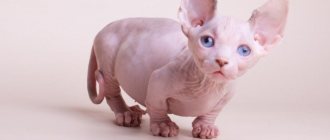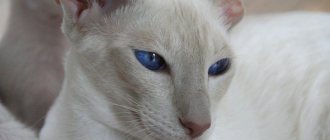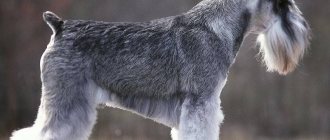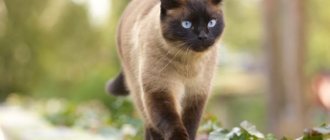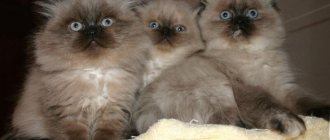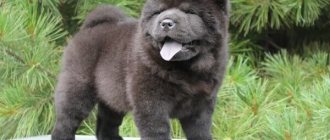Canadian Sphynxes are one of the most unusual and unique cats. Smooth skin without hair makes their image refined and sophisticated, emphasizing grace and stature. Often their appearance not only attracts attention, but also inspires creative people, and also becomes the source of rumors about the presence of magical abilities in these animals.
History of the breed
The history of the origin of hairless cats began in 1966 in Canada, when a hairless kitten named Prune was born in the litter of an ordinary cat. Later, in order to preserve and pass on to subsequent generations as many genes as possible, which caused a certain mutation and lack of hair, he was crossed with his mother. In their litter, both regular and hairless kittens were born. Similar matings were repeated several times. So in the 70s. XX century cats without hair appeared, outwardly slightly different from modern sphinxes. Due to the fact that such cats were bred by unprofessional breeders who used a small genetic pool, the development of the breed was slow, and the kittens died en masse.
In 1975, another hairless kitten named Epidermis was born in Minnesota, and a year later, another hairless baby appeared in the same cat's litter. Both kittens ended up in the specialized nursery “Stardust”. Some time later, hairless kittens were again discovered in Canada. The cats in whose litter they were born were transported to Holland, where breeders began branching out the breed, crossing them with Devon Rexes. The first sphinxes were brought to Russia from the USA in the 80s of the 20th century.
Tips for choosing a kitten
You should not purchase a kitten through private sellers. Photos of hairless cats posted on a free message board on the Internet may turn out to be fictitious. Outbred shaved cats are often passed off as Sphynxes. It is almost impossible to spot deception without the help of an experienced breeder or felinologist.
You can purchase a healthy and purebred animal from a large nursery or from a professional breeder who is a member of a club or association of cat lovers. In both cases, sellers are required to present a license confirming the legality of their activities. Along with the kitten, the buyer must receive a purchase and sale agreement, a veterinary passport and breeding documents. Breeding documents include:
- Metrics. Contains basic information about the kitten and its parents. If the animal belongs to the pet class, then its defects are reflected in the metric: excessive amount of fur, insufficient number of folds, and others.
- Pedigree. Unlike the metric, it is issued at the buyer’s request and increases the final cost of the kitten. If you do not plan to breed or participate in an exhibition, then you can refuse the pedigree. In this case, the price of the pet will be lower.
When choosing among Sphynx kittens, consider your purchase goals. If you buy a pet for the soul, then it is enough to choose a healthy and active animal. Buyers with higher demands are advised to seek advice from a felinologist, breeder or veterinarian.
Breed standard and description
The absence of fur on a cat’s body does not guarantee that it belongs to the Canadian Sphynx. It is necessary that the appearance of the animal meets all the criteria of the breed standard:
- medium-sized head, wedge-shaped, rounded, the length of which is slightly greater than the width;
- the forehead is flat, the transition to the muzzle can be both smooth and pronounced;
- the muzzle is short, cheekbones prominent;
- wide bridge of the nose, short nose;
- open, erect, large, wide ears at the base with rounded tips;
- no whiskers, but their presence in some individuals is not considered a defect;
- large lemon-shaped eyes;
- pear-shaped body with developed muscles;
- wide chest;
- the front legs are shorter than the hind legs;
- bare whip-like tail;
- there are many folds on the neck, limbs, forehead and body.
As adults, female Sphynx cats weigh approximately 3.5 - 4 kg, and males - 5 - 7 kg.
What does the Canadian Sphynx look like?
The general impression made by the sphinxes is deceptive. The illusory weightlessness created by the absence of fur collapses the moment the animal is picked up. A tightly built body is covered in muscles, and muscles are always heavier than fat. Therefore, in the photo, the Canadian Sphynx may seem deceptively fragile.
Muzzle
What does a Canadian Sfinsky look like from different angles? The breed is characterized by a wedge-shaped head. Its width is slightly shorter than its length. The short muzzle is covered with pronounced folds. On well-developed whisker pads, the vibrissae are absent or grow to a short length. The Sphinx has high cheekbones and a strong chin. The transition from a flat forehead to a short nose is weakly expressed.
Huge ears with a wide base are the hallmark of the breed. There is a slight difference in the TICA and CFA standards that determine what the Sphynx looks like. The first organization allows a small amount of hair on the outside of the ears, and the second considers it a breed defect. Fur inside the ears is unacceptable under both standards.
The shape of the large and slightly slanted eyes resembles a lemon. They are widened towards the center and narrowed at the edges. The color of the iris should be in harmony with the color of the coat.
Body type
The head is located on a slightly arched neck of medium length. The body of the Sphinx is heavy and muscular. The muscles of cats are more developed than those of cats. The areas of the croup, abdomen and chest are rounded. The belly resembles a barrel, so it seems that the cat has recently eaten. There should be no fat deposits.
The hind limbs are longer than the front limbs, so the line of the back behind the shoulder blades is raised. The paws have an oval shape and thick pads with long and graceful toes. The fingers are well developed, so cats can open doors or take small objects into them. The animal's tail resembles a rat's. It is long and flexible, and its tapered tip allows for a small amount of hair.
Coat and color
Cats have thick and folded skin. The greatest number of folds is found on the limbs and muzzle. Instead of the classic guard hair and undercoat, soft and short fluff grows on the body. Its length does not exceed 2 mm. The tail, scrotum, outer side of the ears and the interdigital space are covered with short and sparse hair.
The coat feels like suede or velor to the touch. Hairlessness is only visible, so the standard allows any colors of the Canadian Sphynx, except shaded and zonal: smoky, chinchilla, cameo and others. Also, shorn animals are not allowed to participate in the exhibition.
Varieties of the Canadian Sphynx are the St. Petersburg and Don Sphynxes. Recently, in some countries they are considered separate breeds.
Colors
Cats of this breed are distinguished by a variety of colors, each of which is represented by several varieties depending on the predominant shade and the presence of spots or stripes. Below are all types of colors with photos.
Plain
Solid color can be:
- black (n) – the skin is slate gray, the paw pads are black or dark brown, the nose is black;
- blue (a) – light blue skin with a silver tint, gray paw pads;
- chocolate (b) – skin tone varies from bitter to milk chocolate, and pads from light brown to pink, the nose is pigmented to match the main color;
- lilac (c) – the skin color combines cool silver and pink shades, the paw pads and nose are painted lilac-pink or lavender;
- red (d) - skin color varies from bright red to pink, and paw pads and nose from brick red to deep pink;
- cream (e) – the skin is any shade of pink, the paw pads and nose are colored to match.
Sphynxes of white (w) color are also common. Such animals have white skin, and the nose, eyelids and paw pads are pale pink.
Bicolor
This is a solid, tabby or tortoiseshell color, with the addition of white, which is separated from the colored part by clear boundaries. Found in Sphynx cats of both sexes. A bicolor Sphynx must have one ear and tail colored (a white tip is acceptable), and it is advisable to have a large colored spot on the head.
Harlequin
An intermediate option between the bicolor and van colors. Such cats have a colored tail, one ear-covering spot on the head, and several more spots on the body and, possibly, on the paws. The nose and paw pads are pink.
Wang
The Sphinx is almost completely white. He has a colored tail and a spot on his head that covers his ears. A maximum of 3 stains are allowed on the body.
Color point (Siamese)
Color variations:
- cream point - skin color varies from light cream to white, cream ears and tail, pink nose and paw pads, blue eyes;
- seal - point - kittens have a light body, and the nose, paws, ears and tail are black-brown; adult cats have a completely dark body and blue eyes;
- chocolate - point - golden-brown body, blue eyes;
- tabby-point - the body is light, there are stripes on the muzzle, paws and tail, and a dark edging on the pink nose.
Kittens with this color are born completely white; after some time, the tip of the nose, edges of the ears, paws and tail acquire a characteristic shade.
Tortoiseshell
The “turtle” color also has several varieties:
- black (f) – spots of black and red colors are located on the entire body;
- blue - cream (g) - the color is obtained as a result of an uneven mixture of cream and blue (gray) colors;
- lilac (j) – the result of a mixture of cream and lilac colors;
- chocolate (h) – red and chocolate spots are located on the body.
Only cats can have tortoiseshell coloring.
Codes
The World Cat Organization has developed a code for breeds and colors, consisting of several groups:
- 3 capital letters denoting the breed (Sphynx - SPH);
- color code – a lowercase letter describing the base tone of the skin or coat + lowercase “s” for silver or “y” for golden;
Numbers are indicated if necessary to indicate a certain characteristic (eye color, tail length, presence of spots and their color).
| Code | Color/color |
| 01 | Wang |
| 02 | Harlequin |
| 03 | Bicolor |
| 09 | spotting |
| 21 | Tabby |
| 23 | Mackerel (tiger) |
| 24 | Spotet (a type of tabby) |
| 31 | Burmezsky |
| 32 | Tonkinese |
| 33 | Colored or Siamese |
| Eye color is indicated only in white animals | |
| 61 | Blue |
| 62 | Orange |
| 63 | Odd-eyed |
| 64 | Greens |
For example: EMS - the code describing the Canadian Sphynx with the blue bicolor color looks like SPH a 03.
Characteristics of Canadians
It is worth listening to reviews from owners about the character of Canadian breed cats. As a rule, they sing long praises to their pets, but, to the animals’ credit, the odes of praise are fully deserved.
The character of these cats is similar to other four-legged animals - dogs. Cats are easy to train, as they are quite intelligent and can learn to fetch small objects and perform various tricks such as opening windows and doors.
They begin the training process by training them to use the tray and responding to their name. A kitten of this breed remembers all this almost the first time.
Sphinxes are very socialized, so they prefer to communicate with their owner, to whom they are infinitely loyal. The cat and the owner can watch TV together for a long time, and then also go for a walk around the apartment together.
The sphinx reacts calmly to other animals; the hunter's skill is fast asleep in him.
Cat character
Canadian Sphynxes are affectionate and good-natured animals with an easy-going disposition that is not characterized by aggression. They choose one owner for themselves, to whom they become strongly attached and need his constant attention, communication and care; they find it difficult to tolerate loneliness. These cats see authority in the owner, which is primarily due to their dependence on people: Canadian Sphynx cats do not have a coat that would protect them from the cold, and whiskers that allow them to hunt, so without an owner they will die.
Representatives of this breed are absolutely not jealous and are able to capture people’s moods and emotions and quickly remember the habits of their household members. Thanks to this, they easily find a common language with people and develop a certain style of communication with all family members. “Canadians” are not aggressive, patient and very playful, so they get along well with children and enjoy spending time with them.
Sphinxes are not characterized by capricious behavior, vindictiveness, or touchiness. They do not harbor a grudge against their owner even after undeserved punishment and are the first to make peace. Representatives of this breed need active games, including not only physical training to maintain muscle tone, but also exercises to develop intelligence.
Character
Sphynxes are affectionate and friendly animals. Usually they choose one person and become strongly attached to him. At the same time, the owners are treated as equals and do not try to please them.
These animals are in dire need of warmth - both literally and figuratively. They love the attention of their owner, while trying to be as close to him as possible in order to warm up. They sit happily in your arms and love to spend the night in their master's bed, under the blanket. To the best of their ability, they take part in all the affairs of their person and accompany him around the house. They can “maintain a dialogue” by meowing in response to words addressed to them, and their “speech” is distinguished by great intonation diversity.
Many owners claim that Sphynx cats love to pose in front of a camera or video camera. This breed is a champion in the number of roles in films.
Sphinxes treat children well and even try to “educate” and protect them in their own way. They are balanced and unvindictive - they need company too much to allow themselves to show resentment for a long time. Sphinxes are active, inquisitive, easy to train and quickly adapt to new conditions.
In good weather, sphinxes can be walked on a leash
They are friendly towards new people, and sometimes they can choose their favorite guest to whom they will pay special attention. They treat other animals well; most often they are not afraid even of unfamiliar dogs.
Sometimes, due to too active games, something can break or break. Some individuals are unclean, in particular, they neglect the litter box and do not lick themselves after using the toilet. They can steal food.
Sociable is too small a word to describe this creature. Now you will always brush your teeth together, take a bath, watch TV, read a book, cook dinner, clean the house, and, of course, sleep. Since childhood, the Sphinx believes that there is no better assistant in the world than him. He alone knows how to properly stir salad, arrange your figurines on shelves and take a bath. There is no use in getting angry about this. Just get used to the fact that a bald fat belly is always jumping next to you.
Sattvika
https://otzovik.com/review_1163751.html
Maintenance and care
Canadian Sphynxes are gentle and sensitive animals. Due to the lack of wool, the issue of hypothermia is acute for them, so it is important to maintain the room temperature at least +20 - 25 ° C, and in winter and during the off-season they will need warm clothes. It is necessary to allocate a place for your pet to eat and place 3 bowls there: for water, food and other products. You also need to purchase a bed, house or other sleeping place for him. In general, caring for Canadian Sphynx cats is a set of hygiene procedures that must be carried out regularly.
Bathing and skin
Cats have glands throughout their bodies that produce a substance that protects the skin, making it dirty and covered in plaque. To remove it, wipe your pet with a damp sponge or alcohol-free cloth. You need to wash your cat no more than 2 times a month, using special mild shampoos and conditioners, and the water temperature should be about +38 °C. You need to apply shampoo to the sphinx, lather it and go over the contaminated areas with a sponge. Then thoroughly rinse off the foam and wipe your pet dry.
Eyes
Sphynx cats do not have eyelashes, so their eyes are not protected from dust and dirt. You need to wipe your eyes daily with a cotton pad soaked in tea leaves, chamomile solution, boiled water or a special product.
Normally, discharge from the eyes should be clear or brownish.
Teeth
To eliminate the possibility of plaque and tartar formation, you should regularly care for and clean your Sphynx's teeth with a special brush and toothpaste intended for animals.
Ears
These cats have rather large ears, in which brown discharge accumulates. You need to clean your ears weekly using cotton swabs. After cleaning, the ears should be treated with a special powder.
Claws
It is necessary to regularly trim your cat's claws with special sharp pliers. This must be done carefully, cutting off only the transparent tip and without touching the blood vessels.
Tail
Wipe the outside of the tail with degreasing agents to remove secretions from the sebaceous glands.
The character of the Canadian Sphynx: 7 features of these cats
Not all sphinxes are the angels that breeders sometimes try to make them out to be. Much depends on the conditions of detention and the correct behavior of the owners. And most importantly, it depends on how compatible the temperaments of the sphinx and the people with whom it lives are. At the end of the section you will see a table that clearly shows that the same character trait can be both a plus and a minus.
Sociable
If you think that a cat should be independent and inconspicuous, the Sphynx is not for you. This breed is famous above all for its desire to communicate. The Sphinx is always next to its owner, no matter what he does.
Hello, do you need any help?
Baby yoga, or rather cat yoga
These cats climb on your hands at every opportunity, and can jump on your shoulders if you don’t wean them off. They spin around under your feet and actively help in everyday life - they throw themselves on a floor rag, take away your toothbrush, and chew on the pen you are trying to write with.
In addition to physical contact, the sphinx communicates through “talking”. Canadians meow a lot and willingly, and in different ways, depending on the occasion.
Active
The Canadian Sphynx is a real energizer, especially when young. This cat needs active games. The Sphynx can chase a teasing rod until he becomes out of breath, which is definitely not what you would expect from more phlegmatic breeds like the British.
A naked kitten is often called a monkey in people's hearts - not because of its external resemblance, but because of its endless pranks. A Canadian Sphynx left unattended can turn an apartment upside down. Perhaps only Abyssinian or Bengal cats can surpass them in activity.
What are you looking at, turn back!
Kittens are very active and always ready to play
Affectionate
One of the advantages of the Canadian Sphynx is their love of love. They always readily respond to affection, and they themselves demand attention, butting and rubbing themselves against their owners. In case of conflict, the Sphinx prefers to run away and hide rather than engage in open confrontation. This breed is not characterized by aggression.
You smell like chicken, can I lick you?
Curious
Even if the sphinx does not leave the apartment, it will continue to explore the space again and again. It is very important to install protective screens on windows and remove wires and other hazards from access.
There's nothing interesting in the closet, I checked
Gluttonous
Sphynx cats have an intense metabolism and require more food than a regular cat of the same size. You'll be surprised how much one naked cat can eat if you give it free rein. Owners laughingly describe how the cat puts its muzzle right into their mouth in the hope of begging for a tasty morsel.
Give me something tasty, man!
Smart
Canadian Sphynxes have developed intelligence, which is confirmed by the stories of their owners. One woman's cat learned to turn off her computer because she picked him up and pet him when she rebooted the computer. In another, he rang a special bell with his paw, demanding food. The Sphynx can be trained simply by observing it and rewarding certain behaviors.
Treat the sphinx!
Touchy
The Canadian Sphynx cannot be punished. The cat won’t understand why, and you’ll make the problem worse. If your kitten scratches your legs while trying to climb up, you shouldn't spank him. You should not poke a cat into a puddle made in the wrong place, even if it was your pillow.
Sphynx cats are gentle and affectionate cats, but their trust is easily destroyed by impulsive actions. If you are taking a naked kitten into your home, you better be patient in advance.
Glass left unattended - shared
The character of the Canadian Sphynxes: pros and cons
Character Trait Plus- Minus
| Sociability | A sociable and affectionate pet, a lot of positive emotions. | Does not tolerate loneliness well, can be intrusive and disturb. |
| Curiosity | Sphynxes are not cowardly, they make contact with other animals, adapt when moving, and love to learn new things. | They climb into places they shouldn’t, which can lead to injury – a window, a washing machine, a dresser drawer. |
| Voracity | The pet will not be picky, willingly gobbling up the food that you offer it. | Due to the constant feeling of hunger, sphinxes are prone to begging and theft, and if they are overfed, they become obese. |
| Friendliness | The Sphinx is a good companion for children; it is unlikely to bite or scratch unwary children. | If you pay little attention to your sphinx, he will experience stress. The pet needs to be petted a lot. |
| Activity | The cat is always ready to play and will not let you get bored, charging you with its energy. | People often mess around at home - they scratch furniture and curtains, throw things off, and destroy indoor plants. |
You don't need to study, pet the cat!
Feeding
Proper nutrition is one of the main components of healthy growth and proper development of a cat. You can feed Canadian Sphynx cats with both industrial food and natural products; the main thing is to monitor the balance of the diet and take into account the characteristics of representatives of this breed. So, due to the high energy consumption to heat the body, these cats need more carbohydrates than other breeds.
The menu and daily portion size must be selected individually for each individual, taking into account its age, gender, activity level, physiological state and health. As a rule, cats aged 1 - 3 months are fed 5 - 6 times a day, cats aged 4 - 8 months - 3-4 times, and animals 9 months and older are fed 2 - 3 times a day. The portion should be calculated based on the weight of the animal - the food norm is 5% of its body weight.
Feeding representatives of this breed also allows a mixed type of nutrition.
Natural food
A natural diet should consist of 70-80% meat and meat products, and the remaining 20-30% should be divided between vegetables, fruits, herbs, dairy products and cereals. On average, an adult cat needs to consume 200 - 250 g of proteins and 100 g of carbohydrates per day.
The pet’s menu for this type of nutrition should include:
- meat (poultry, rabbit, veal, beef) - daily;
- boiled beef or chicken offal (kidneys, heart, tripe, lungs, etc.), boiled sea fish, rice and buckwheat cereals, vegetables (pumpkin, carrots, cucumbers, cauliflower
- cabbage, green beans), fruits, greens (spinach, parsley) - three times a week;
- fermented milk products (ryazhenka, cottage cheese, kefir, yogurt), raw yolk - twice a week;
- cheese – once a week.
Additional intake of vitamins and minerals is also necessary, but only after consultation with a veterinarian.
To brush your teeth, you should give your pet crackers once a week.
What not to give
It is forbidden to feed cats:
- canned food;
- pork;
- whole milk;
- peas;
- beans;
- mushrooms;
- nuts;
- seeds of apples, pears and peaches;
- sausages;
- pastries and cakes;
- smoked, fatty, spicy foods;
- chicken and fish bones.
Also, you should not give your pet boiled eggs, since the cat’s body does not digest them.
Dry food
If the diet of representatives of this breed is based on dry food, their choice must be approached responsibly. The food must correspond to the age of the pet, its physiological state and have a good composition, in which at least 26 - 30% proteins, and the first 3 places in the list of ingredients are meat.
You should not purchase low-quality, cheap products. Canadian Sphynx cats are only suitable for premium, super premium and holistic food. One of the main advantages of dry food, in addition to ease of storage and use, is that their granules are coated with a special composition, which helps to naturally clean teeth from plaque.
The most suitable food for representatives of this breed:
- holistic – Orijen Cat and Kitten and Acana Grasslands for Cats;
- super premium class – Purina Pro Plan Delicate;
- premium class – Royal Canin Sphynx Adult, Hill`s Science Plan Adult Lamb.
The daily food consumption rate is indicated by the manufacturer on the packaging.
Feeding a kitten
Until about 1 month, the kitten's diet consists only of mother's milk, then it is necessary to gradually introduce complementary foods consisting of semolina porridge or egg yolk.
After 2 months, the kitten’s menu should include:
- boiled or raw beef;
- calcined cottage cheese;
- boiled quail eggs;
- pre-soaked dry food for kittens.
The following foods are suitable for kittens of this breed:
- Royal Canin Babycat Instinctive;
- Royal Canin Kitten;
- Purina Pro Plan Junior Chicken;
- Wahre Liebe "Junge";
- Hills Cat Science Plan Kitten Tuna.
From 3 months you can give your Sphynx boiled sea fish, herbs, vegetables and fruits, and grains.
Nutrition for illnesses
Sphynx cats have a sensitive digestive system, so any mistakes made by the owner when feeding the cat can lead to quite serious problems with its health. If your pet has problems with the gastrointestinal tract, you should switch it to one of the special foods:
- GO Sensitivity Shine;
- 1st Choice;
- Gina Elite Cat Sensitive;
- Josera SensiCat;
- Bozita Feline Funktion Sensitive Diet and Stomach;
- Hill's Science Plan Sensitive Stomach;
- Royal Canin Sensible 33.
You must first consult a veterinarian.
Catering
Babies aged 3-5 months eat 4-5 times a day, gradually the number of meals is reduced. A kitten older than 6 months eats 2 times a day.
Pictured are kittens of the Canadian Sphynx breed
Recommended food
Sphynx cats need to be fed holistic or super-premium food. These are Acana, Fitmin For Life, Brit Care, Blitz. This is high-quality food containing: fresh meat and meat ingredients, vegetables, oats, barley or rice, mixtures of tocopherols, rosemary and other useful ingredients.
Below are recommended super-premium foods. Links with the names of the food are clickable, on them you can, within our website, get acquainted with the descriptions of the food and read reviews from owners of Sphynx cats.
| Super premium | Super premium | Super premium |
| Leonardo | SUPERPET | Organix |
Premium and economy classes for the Sphinx are not worth taking. These foods contain a lot of vegetable protein (which is poorly digestible), unknown preservatives and antioxidants, and instead of meat - meat waste and tripe.
Natural products
Natural food is prepared separately for cats. You cannot feed them soup or stew from your table, because there are many things that animals simply cannot eat.
Allowed to include in the diet:
- meat scalded with boiling water (beef, rabbit, chicken, turkey);
- sea fish (no more than once a week);
- low-fat fermented milk products (sour cream, cream, kefir, fermented baked milk, cottage cheese, bio-yogurt);
- boiled chicken yolk;
- hard cheeses;
- porridge (buckwheat, oatmeal, millet, rice, semolina);
- vegetables (pumpkin, zucchini, green beans).
Cook the porridge in water, add a few drops of sunflower or olive oil to the portion.
You cannot give the sphinx:
- Fatty meats: duck, goose, pork;
- River fish;
- Lard, sausages, bones, sausages, sausages;
- Smoked, sweet, salty, flour, baked goods;
- Human canned food, sauces, mayonnaise, seasonings, spices;
- Potatoes, tomatoes, garlic, onions;
- Coffee, tea, sparkling water, mineral water.
Features of pet socialization
Canadian Sphynxes are sociable, inquisitive animals that easily adapt to environmental conditions. Thanks to their inherent sociability, cats quickly find a common language with people and animals, so there are no problems with their socialization. These cats are not afraid of other, even larger animals, including dogs. The lack of fear also helps them get along with animals and get along without problems in the same territory with any other pets. This is an exclusively decorative breed of cats, so “Canadians” do not even see mice as objects of hunting.
Raising a Sphynx
After the kitten appears, it is important to start raising it. For toilet training, buy several trays and place them in places where your pet tries to relieve himself. Gradually reduce their number and move them closer to the bathroom or toilet. Don't scold your baby if he goes past the litter box. Wipe the area with vinegar solution or spray with anti-cat spray. Be sure to praise your pet if he has done his business in the right place. Praise will generally have a beneficial effect on the education of the Canadian Sphynx.
If problems with the tray occur in an adult animal, then try to understand the possible causes. Sphynxes are clean cats. If they mark territory, this may be due to stress or a physiological disease (cystitis, urolithiasis, diabetes).
All cats wear down their claws, so discourage attempts to scratch the sofa and offer an alternative. Multi-level scratching posts are suitable for sharpening claws and maintaining physical fitness. Some pets use such structures only for play. Try to solve this problem with a horizontal scratching post.
Training cats is more difficult than training dogs. With constant training, the Sphinx can be taught basic commands. Start training the commands “come to me” and “fetch” no earlier than 8-9 months. Try to give exercise in the form of a game and be sure to reward your cat with treats for its success.
Intellectual abilities
Canadian Sphynx cats are quite intelligent and have a good memory; teaching them the rules of behavior in the house does not take much time and is not difficult. Cats quickly remember their name, place of the toilet, easily socialize and get used to the daily routine established by the owner. Thanks to their developed sense of logic, lack of discomfort while walking on a leash, the ability to open and close doors and perform tricks, as well as the ability to fetch small objects in their teeth, many compare these cats to dogs.
Breed card
| Characteristics of a cat | Notes | |
| General information | The Canadian Sphynx is the original breed that created the fashion for “hairless” cats | The birthplace of the breed is Canada |
| Character | Playful and affectionate cat, very attached to family members | The Sphynx's playfulness does not disappear with age |
| Appearance | Medium-sized cats, wedge-shaped head, numerous folds on the skin. A large number of colors. Several types of wool: naked, velor, flock, brushed | Cats feel hot and velvety to the touch |
| Behavior at home | They love to curl up in a ball and sleep under a blanket, and also climb onto their owner’s shoulders. | Sunbathing lovers |
| Care | Weekly bathing and wiping with wet wipes to remove excess sebum and sweat | |
| Health problems | Various skin diseases and hypertrophic cardiomyopathy occur | Cats are afraid of cold and extreme heat |
Specifics of training
Representatives of this breed are distinguished by a good memory that does not turn into rancor. They remember words prohibiting any actions and understand them perfectly. At the same time, screams and rude treatment cause them bewilderment - the cats are lost and do not understand what is happening. Therefore, you should not shout at sphinxes, this will only lead to stress for your pet and repetition of mistakes.
Physical punishment is also prohibited. In order for a cat not to experience psychological trauma, to respect its owner and to react properly to prohibited words, it is necessary to establish friendly and trusting relationships with it, and the use of brute force does not fit with this. Only words and intonation can be used to punish.
Who is not recommended to start
Canadian Sphynxes are quite unpretentious animals and can find the key to the heart of any person, however, there are features that you need to pay attention to before buying a hairless baby.
- Allergy . If you suffer from an allergy to cats, then even a hairless pet will not save you from it. In most cases, the allergen is cat protein, which is found in saliva, sweat and feline waste. And Sphynxes sweat all over their bodies, unlike other breeds!
- Lack of time for care . The need to bathe your pet weekly will raise serious doubts for some people. If you want a cat that doesn't require any maintenance, then the Sphynx is not for you.
- Frequent absence from home . Sphynxes are attached to their owners, so a prolonged absence of human communication is always stressful for the pet. You should not choose a Sphynx as a pet if you lead an active lifestyle outside the home.
Walking and exercise
Sphynxes are not adapted to living outdoors and do not need frequent and long walks. At the same time, they feel comfortable on a leash, so from time to time in good weather you can take your pet outside for a short time - fresh air and warm sun have a positive effect on his well-being. You can equip your cat with a place on the windowsill so that she can enjoy the sun's rays without leaving the house.
Prolonged exposure to direct sunlight can cause skin to peel.
The lack of need for walks does not negate the need of these cats for physical activity and active pastime. It is necessary to place special equipment and labyrinths in the house so that the sphinx can play, expend energy and maintain physical fitness.
Advantages and disadvantages of the breed
Positive aspects of choosing Canadians as a pet:
- lack of hair;
- gentle, friendly character;
- amenable to training;
- get along with other animals;
- good health;
- extraordinary appearance.
The disadvantages of the breed are:
- the need for careful body care;
- excessive physical activity;
- skin sensitivity to cold and sunlight.
For your information! Many Canadian owners complain that their pets are especially sensitive to the smell of the toilet. Cats refuse to go to the same litter several times, so the contents of the tray have to be changed 2-3 times a day.
Health and illness
Canadian Sphynxes have fairly good health and strong immunity. Health problems are most often caused by hypothermia, poor hygiene or late vaccination. However, there are a number of diseases characteristic of this breed. Most often, Sphynx cats are diagnosed with acne of various types, seasonal dermatitis, vasculitis, urticaria pigmentosa and other skin diseases.
Only a veterinarian can make a correct diagnosis based on test results. All these pathologies have many causes, but with timely contact with a veterinarian they respond well to treatment. These cats are also prone to obesity, so you need to take a responsible approach to their diet and avoid overeating.
In addition, breed diseases of Canadian Sphynx cats include:
- hypertrophic cardiomyopathy – a heart disease caused by a genetic mutation;
- myopathy is a hereditary pathology acquired during breeding work with Devon Rex and cannot be treated, progresses individually, manifests itself at 4 - 7 or 12-14 weeks, often leading to death;
- microphthalmos and entropion of the eyelids - abnormal development of the eyes, probably caused by a gene mutation and manifested in complete blindness, cataracts or cancer;
- malocclusion is an abnormal development of the jaws, in which the lower jaw is shorter than the upper one due to which the incisors do not align;
- nipple hyperplasia is a hereditary pathology transmitted through the female line and cannot be treated;
- breast cyst – most often develops as a result of long-term use of antisex drugs;
- “sleep syndrome” is a genetic pathology consisting in congenital underdevelopment of the thymus gland.
Body temperature 38 -38.5 °C and rapid heartbeat are the hallmarks of the Canadian Sphynx.
Diseases
Sphinxes have good immunity, but there is a whole list of hereditary diseases. Therefore, you will need to find a good veterinarian as soon as you bring a kitten into your home.
- Hypertrophic cardiomyopathy - this disease is expressed by hardening of the walls of the heart ventricle and without timely treatment leads to early death. You cannot get rid of it, but with the help of medications you can significantly improve your quality of life and prolong it.
- “Carp bite” is a shortening of the lower jaw. If the pathology is mild, the cat adapts well to it. In difficult cases, surgery is required.
- Microphthalmos is underdevelopment of the eye. Leads to the appearance of cataracts, keratitis, and decreased visual acuity.
- Inward turning of the eyelids is a physical defect that causes a series of inflammatory processes and conjunctivitis. Minor surgical correction is allowed.
- Curvature of the spine, or only the caudal region. It occurs frequently, and sometimes in combination there is an abnormality of intestinal development, underdevelopment of the vertebrae, or dwarfism.
- Thymus underdevelopment is a fatal disease. Alas, it can neither be predicted nor cured. Kittens die a few days after birth. The reason is the same - inbred crossing.
Even if your pet does not leave the house, it is necessary to carry out deworming and vaccinations on schedule. This will save your pet from harm, because pathogens can be brought home on outdoor shoes, clothes and hands. Before petting your cat, be sure to wash your hands thoroughly!
Mating
The first heat in cats occurs at 6 - 7 months, cats reach sexual maturity by 8 months. It is better to breed a cat for the first time after 2 - 3 heats, when she is 1.5 - 2 years old, since before that the animal is not physically ready for pregnancy.
For mating to be successful, you should:
- show the cats to the veterinarian in advance to eliminate the possibility of illness;
- trim the animals' claws so that they do not accidentally injure each other;
- 14 days before mating, carry out deworming;
- use an experienced cat for breeding.
Before the mating date, the cat should not be bathed - washing eliminates the specific smell that attracts the cat’s attention. Mating is carried out on the territory of the cat, the owner of which must provide the cat with favorable living conditions in his home, since the animals must be together for 2 - 3 days.
The most suitable time for mating is the 3rd - 5th day of estrus.
Features of reproduction
The first heat in cats begins at 6–7 months, and cats reach sexual maturity at 7–8 months. However, for both of them mating is prohibited at this time, otherwise there is a risk of permanently damaging the animal’s health. Cats can only be bred after 3–4 heats. For cats, the optimal age for first mating is from 18 to 24 months.
Pregnancy lasts about 63 days. Childbirth may occur 3-5 days earlier or later - this is considered normal. In other cases, you should contact your veterinarian. A litter can have from 1 to 12 babies. Some kittens are born with rex hair, but gradually lose it and completely go bald at 3 months. For females, one pregnancy per year is allowed, with good health - no more than two.
If you do not plan to use the animal for breeding, it is advisable to castrate or sterilize it. Some experts call the best age for this 7–8 months, others - 1 year. As this may vary from person to person, it is best to discuss this with your veterinarian in advance.
Canadian Sphynx cats have a well-developed parental instinct.
Breeding Sphynxes
Breeding Sphynx dogs is a complex undertaking, and you need to carefully study the genetic characteristics of this breed before taking it on.
Since “Canadians” have a recessive baldness gene, both parents must be carriers of it, otherwise even outwardly flawless animals may produce offspring with fur. To consolidate good traits, some breeders use closely related crosses, but beginners should not conduct such experiments without the participation of an experienced breeder.
Do not cross "Canadians" with representatives of other breeds. Although this is sometimes practiced to breed hybrids (eg bambino), the chances of success are very low. You cannot breed two completely naked animals, as well as sphinxes of different species, for example, the Canadian and the Don - they have different natures of hairlessness, and the offspring are either sick or with a problematic set of genes.
A number of breeders note that sphinxes are very selective and do not always engage in communication even at the right time. In addition, they may “fall in love” with a partner and refuse to deal with others. If for some reason you do not plan to mate again with the same individual, you can look for an animal partner of the same color, but this does not guarantee success. The opposite situation is also possible: if a cat and a male cat got into a fight, in the future one of them or both may refuse to mate with an animal of the same color as the “offender.”
The search for partners can be done through nurseries, clubs, advertisements on the Internet and at exhibitions. It is important to carefully check the pedigree of candidates. Before mating, animals must be vaccinated and treated against worms. It is advisable to carry out mating on the third day of estrus in the cat’s territory.
Some females do not bear offspring. With a genetically incorrect choice of parents, “kitten falling asleep syndrome” is possible, when apparently healthy babies die in their sleep. Most often this happens from the second to the tenth day of life.
Pregnancy
During pregnancy, a cat's behavior may change - some Sphynx cats become apathetic, others behave aggressively, and others require even more attention from the owner. Changes may also affect the pet’s food habits and appetite: the cat may refuse previously favorite foods, lose appetite, or, on the contrary, eat more and more often than usual. On average, the pregnancy of the Canadian Sphynx lasts 60 - 68 days, and the litter consists of 2 - 5 kittens. But there are known cases when 7 - 9 or even 12 kittens were born in one litter.
How much does a Sphynx cost?
The price of a Canadian Sphynx starts from 8-15 thousand rubles. For this amount you can purchase a pet-class animal. For breeding, it is recommended to take animals from American or European nurseries with good pedigree. For elite cats you will have to stand in line. The waiting period can take up to 5 years.
If the number of awards won by the kitten’s parents is not a priority, then check reviews of nurseries in your city and feel free to go for the first meeting with your future pet
Castration and sterilization
Castrated and sterilized cats live on average 2-3 years longer than those who have not undergone surgery. After the operation, cats have no problems with hormones, their behavior returns to normal, and the desire to run away from home disappears. The likelihood of prostatitis and other diseases of the reproductive system is minimized. In cats, due to the absence of estrus and hormonal changes in the body, the risk of developing cancer of the reproductive system, pyometra and other pathologies is significantly reduced. If there are no plans to breed the breed, it is better to carry out the operation as early as possible - young animals tolerate anesthesia more easily and recover faster.
Spayed and neutered animals are prone to obesity and therefore require a special diet.
Ear and eye treatments for Sphynx cats
These cats have fairly large ears. Due to the speed of processes in the body and body temperature, after some time dark brown discharge appears in the ears.
They do not pose any threat, but they significantly spoil the appearance of a noble cat. To clean the ear cavity, it is recommended to use regular cotton swabs. Do not be too zealous, otherwise the cat may develop otitis media or more serious diseases.
Due to the genetic characteristics of the breed, Sphynx cats completely lack eyelashes, which leads to an increased level of dirt accumulation.
Experienced veterinarians remind that if cats experience “estrus” in the eyes, then you should pay attention to the nature of the discharge. If white or yellow streaks are detected, you should immediately contact a specialist, because this is a clear indication of infectious diseases.
You can wipe your eyes with tea leaves, furatsilin or ordinary boiled water.
Dental procedures require close attention. After all, if you neglect your cat’s oral hygiene, the gums will become inflamed and the teeth will begin to mercilessly ache. Also, a likely outcome of the owner’s omissions may be the development of dental calculus.
To avoid such a fate, you should brush your teeth weekly with a specialized toothpaste, which can be found at any veterinary pharmacy. You need to choose a soft brush that will not injure the animal’s delicate gums.
Required vaccinations
| Age | Vaccine |
| 6 - 8 weeks | Vaccination against panleukopenia (FPV), rhinotracheitis (FVP), calicivirus (FCV) |
| 12 weeks | It is advisable to conduct an ELISA test. If the result is negative, the leukemia vaccine (FeLV) is given, and the FPV, FVP and FCV vaccines are also given again |
| 16 weeks | Rabies Vaccine, another booster against FPV, FVP and FCV and a booster against FeLV |
| 15-16 months and then annually | Vaccinations against FPV, FVP and FCV, FeLV and rabies |
| Vaccination against pneumonia (FPN) is necessary if there are many cats in the house or the Sphynx lives in an area unfavorable for this disease | |
Vaccinations may not be effective if the rules for application, storage or use of the vaccine are violated, or if the cat is sick or in poor physical condition.
Conclusions about the breed
It is not for nothing that the Canadian cat - the animal is very graceful, beautiful and has a high level of intelligence.
The owners of Sphynx cats do not complain about the cats being picky about food, but they warn that it will not be possible to take care of their pet carelessly.
The animal of the Canadian Sphynx breed needs increased attention from the owner, and the time that the cat spends in the house becomes happy for the whole family.
global $ads_google; //data-ad-slot=”2475549904″ $ads_google = empty($ads_google) ? false : true; ?> if ($ads_google == false) {?> $ads_google = true; ?> } ?>
How to choose a kitten?
You should choose and buy a kitten from a specialized nursery - this guarantees its purebredness and minimizes the likelihood of any diseases. It is important to examine the kitten for compliance with the standard and the absence of symptoms of pathology. Irritation, redness, acne on the skin, exhaustion or excess weight, increased lacrimation and discharge from the eyes, nose or ears are symptoms of pathologies. The kitten should be active, sociable, playful, and not show aggression or fear.
How to care for Sphynxes
Due to the nature of their skin, sphinxes require special care. Their skin is somewhat similar to human skin; for example, they, like us, can burn in the sun. These hairless cats sweat and their skin produces oil. Therefore, they need to be bathed once or twice a week and regularly wiped with a soft, damp towel to remove skin discharge. If you refuse such hygiene procedures, over time the skin will become covered with a sticky fatty coating, dirt will accumulate in the folds, and the animal will begin to smell not too pleasant.
Ear cleaning is another mandatory procedure when caring for hairless cats. For this it is better to use special lotions. The eyes also need to be regularly cleaned of secretions that accumulate in the corners.
Sphynxes also need to have their claws trimmed regularly. This can be done at home or in a veterinary clinic.
Choosing a name
Breeders give names to purebred kittens, focusing on certain rules: names must begin with a letter corresponding to the serial number of the litter, they must use the first letters of the names of the mother and father, as well as the name of the nursery where the kitten was purchased. The choice of a pet name is not limited by the rules, but it should be remembered that such an unusual animal needs an appropriate name.
| Names for girls | Camilla, Amalia, Lixie, Amanda, Agata, Osti, Bella, Eva, Leah, Lana, Fabira, Vita, Aurora, Aika, Adriana |
| Boy name | Noir, Tair, Argo, Weiss, Laurie, Edmond, Riggi, Count, Veron, Dary, Elf, Lucky, Tyson, Tristan, Freeman |
Origin story
Mentions of hairless cats can be found in the chronicles of different nations. This is due to the fact that a hairless kitten could appear from completely ordinary parents. Initially, such unusual kittens were considered discarded.
Reference! The appearance of the Sphinx is considered a natural mutation.
Officially, the birth of the breed is considered to be 1966. Then in Toronto (Canada) a domestic cat gave birth to a hairless kitten. The cat's owner gave the baby the name Prune (Prune). At the same time, sphinxes began to appear in nurseries.
Initially, the kittens were called “Canadian Hairless Cat,” but not everyone liked such a long and ordinary name. Fans of hairless cats were looking for a euphonious name for the breed and drew parallels with the oldest surviving sculpture - the Egyptian Great Sphinx.
"Tabby"
On the animal’s legs there are visible “necklaces” on the neck. The tail is also “ringed”. On the forehead the stripes form the letter “M”. A bizarre butterfly-shaped pattern spreads from the eyes along the cat’s cheeks. There are uniform stripes throughout the body.
The color variations of "tabby" are largely the same as solid colors. The animal’s body may have silver, lavender, fawn, brown, blue, chocolate, red, cinnamon, and cream spots.
Silver tabby
There are black markings on a cold silver background. Lips and chin are earthy in color.
Brown tabby
The main tone is copper, brown. There is a black pattern running across it. The chin, eye rims, and lips should be the same color. Hind legs - with black heels.
Blue tabby
The main shade is silver, pale gray. A more saturated blue pattern runs along it - the contrast is visible to the naked eye.
Red tabby
The main tone is warm soft red. The pattern is rich red.
Cream tabby
The main shade is pale soft cream. The pattern is buff color or a richer “cream”.
Chocolate tabby
Available in two varieties:
- Chocolate chestnut. The skin is a delicate, warm fawn color. There is a rich chestnut pattern running along it.
- Chocolate silver. The main tone is grayish with a cold metallic tint. It has chocolate-colored markings.
Cinnamon tabby
Again two variations are allowed:
- Cinnamon tabby. The main tone is light honey. The pattern is a rich cinnamon color.
- Cinnamon-silver tabby. The main color is metallic, “shiny silver”. Decorated about.
Lavender tabby
Breed standards also allow two varieties:
- Lavender tabby. The skin tone is pale lavender with a pinkish tone. The markings are a rich lavender (gray-lilac) hue.
- Lavender-silver tabby. Background color – cold milky, “transparent silver”. There is a darker lavender pattern running across it.
Fawn Tabby
The main shade is “ivory”. The pattern on the animal's skin is fawn, yellowish-brown.
Tiger type "Canadians":
Raising a pet
The Canadian Sphynx is a very sociable animal, gentle and affectionate. When his owner returns from work, he will sit by the door or jump into his arms. These animals require proper attention from humans. You need to play with him and generally spend a lot of time. You should not leave him alone for a long time, as he will experience psychological discomfort or may even get sick. However, if you make him angry, he may make an unpleasant surprise in the form of wet slippers.
Character traits
The character of the Canadian Sphynx is devoid of an aggressive state towards anyone; this breed is an exception to the rule. They get along well with other animals and play happily with children. They feel good in a large crowd of people in the house, if guests or relatives have arrived. Unlike other cat breeds, Sphynx cats do not tend to show their hunting instincts. Instead, they inherited affection and tenderness from their ancestors. They are loyal to their owners and love to be held. Many people think that the cat is simply warming up in this way.
Specifics of training
These animals can be taught to follow simple commands. This must be done carefully and gradually, without aggression or violence, if the cat does not understand what its owner wants from it. The animal, thanks to its intelligence, learns quickly and remembers everything it has learned, even after a long time.
Adult Sphynx.
Rare colors
In conclusion - less common colors, but allowed by the standard.
"Siamese" (color point)
Kittens are born light, almost white. But as they grow older, a dark “mask” appears on their face, their paws and tail turn black. The eyes remain bright blue.
"Color point":
"Mink"
The baby is also born light-colored, but with age “puts on a coat” - platinum, blue, striped, cream, blue, champagne.

